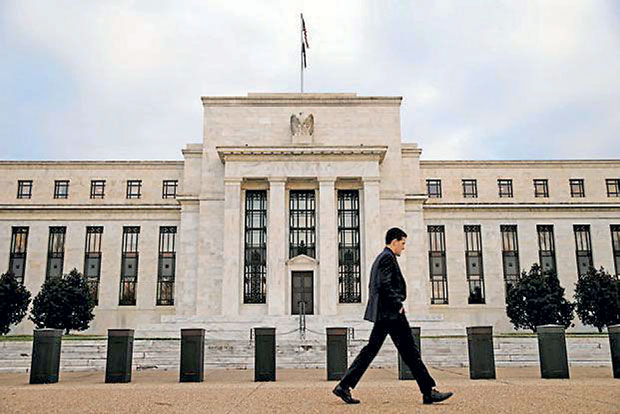13 Jun 2017 - {{hitsCtrl.values.hits}}

 A surprisingly weak run of US inflation data has investors backing off bets the Federal Reserve will meet its three targeted interest rate hikes this year and has breathed fresh life into the bond market after a rough start to the year.
A surprisingly weak run of US inflation data has investors backing off bets the Federal Reserve will meet its three targeted interest rate hikes this year and has breathed fresh life into the bond market after a rough start to the year.
The Fed’s preferred measure of price pressures earlier this year had shown signs of breaking out of five years of stagnation to reach the Fed’s 2 percent inflation goal, partly on hopes of the Trump administration’s fiscal stimulus. But lack of progress on the Trump agenda, only a wisp of wage growth, and three straight months of falling oil prices have sapped that momentum.
Inflation in other major economies has plateaued or is weakening as well. On Thursday, the European Central Bank downgraded its inflation forecasts.
Protracted low price growth hurts the economy as companies struggle to charge more for goods and services, salaries stagnate and investors get low returns. Policymakers worldwide have pegged an annual 2 percent inflation rate as optimal for supporting healthy business and consumer spending growth.
US bond yields and so-called breakeven rates among Treasury Inflation Protection Securities are the lowest in seven months, and the gap between long- and short-dated bond yields has reached the narrowest since last November. Few expect the trend to change soon.
“The inflation background remains challenged. It will keep bond yields low,” said John Bellows, Portfolio Manager at Western Asset Management Co in Pasadena, California.
Investors widely expect the Fed to raise rates at its policy meeting next week as the economy moves toward the Fed’s mandate of full employment. In May, the jobless rate hit a 16-year low of 4.3 percent.
The Fed, which ended its near zero interest rate policy in December 2015, last raised rates in March to its target range of 0.75-1.00 percent.
Conviction on a rate hike beyond next week’s Fed meeting is up in the air.
On Friday, federal funds futures implied traders saw a coin-toss for another rate hike by year-end. And the forward rate curve has flattened, suggesting less confidence in the Fed meeting its forecasts for three rate hikes in 2017 and another three in 2018.
The lowered rate-hike expectations since mid-March has helped to revive a bond market rocked by worries about a more aggressive Fed and higher inflation under President Donald Trump’s policies.
From the end of 2016 to March 14 when the benchmark 10-year Treasury yield reached its 2017 peak of 2.64 percent, Treasuries and other investment-grade bonds lost 0.44 percent, according to an index compiled by Barclays and Bloomberg
Since March 14, the Barclays/Bloomberg US Aggregate bond index has produced a total return of 2.89 percent, bringing its year-to-date return to 2.44 percent.
Inflation misses
Most alarming to investors and a few Fed officials is that the Consumer Price Index and other US inflation barometers have flatlined or retreated from levels earlier this year, raising doubts about whether price growth could reach the Fed’s 2 percent goal.
Along with back-to-back months of the CPI growth falling short of traders’ expectations, the core rate on US personal consumption expenditure slipped to 1.50 percent on a 12-month basis through April, the slowest pace for the Fed’s preferred inflation gauge since December 2015.
A Reuters poll released on Friday showed analysts’ median forecast on US core PCE fell to 1.5-1.7 percent per quarter in 2017 from 1.7-1.8 percent in a prior poll conducted in May. Last month, Minneapolis Fed President Neel Kashkari said the retreat in core inflation was “concerning.”
But the consensus view among Fed officials has been that inflation would reach 2 percent in the medium term.
The bond market has adjusted to the recent sluggish inflation data.
In the US $ 13.9 trillion TIPS market, the yield gap between 10-year TIPS and benchmark 10-year Treasuries, a gauge of investors’ inflation expectations, has steadily narrowed since mid-March to 1.81 percent on Friday.
Speculators have piled on bets in the futures market that the Fed may slow its rate hikes in light of the disappointing inflation data.
Investors are not upbeat about inflation outside the United States either. Their five-year price view on the euro zone in five years hovered above 1.50 percent on Friday, below the ECB’s 2 percent target.
“Inflation isn’t taken off in most developed markets,” said Bill Merz, senior market strategist at US Bank in Minneapolis. But data showed some investors remain confident the setback in US inflation is temporary and price growth would accelerate later this year.
TIPS-focused funds have continued to attract money since late 2016, with their assets reaching an all-time peak of nearly US $ 63 billion in the week ended June 7, according to Lipper, a Thomson Reuters unit.
The US government will release its May CPI report at 8:30 a.m. ET (1230 GMT) on Wednesday before the Fed announces its rate decision at 2 p.m. (1800 GMT).
“For the Fed to carry out more rate hikes, we need to see more inflation,” said Matt Toms, chief investment officer of fixed income at Voya Investment Management in Atlanta.
(REUTERS)
07 Jan 2025 7 hours ago
07 Jan 2025 7 hours ago
07 Jan 2025 8 hours ago
07 Jan 2025 07 Jan 2025
07 Jan 2025 07 Jan 2025